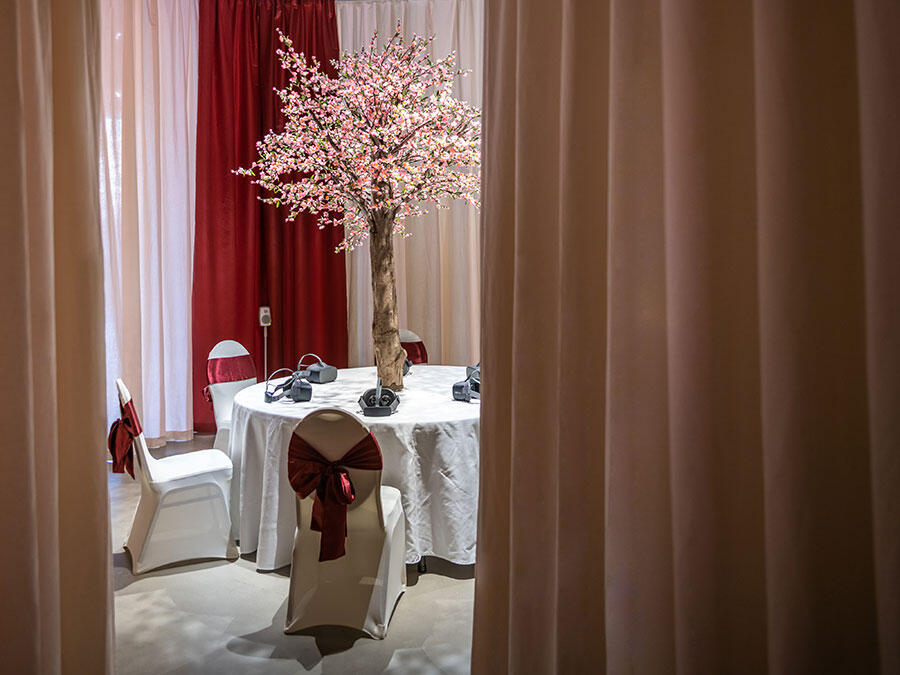The Phantasmic World of Lap-See Lam
At Bonniers Konsthall, the artist's ambitious new video installation uses the ancient Chinese tradition of shadow play to map a diasporic imaginary
At Bonniers Konsthall, the artist's ambitious new video installation uses the ancient Chinese tradition of shadow play to map a diasporic imaginary

In this much-anticipated exhibition, Lap-See Lam debuts the ambitious final chapter in a trilogy of works that engages the aesthetics of Chinese restaurants in the artist’s native Sweden by meticulously 3D-scanning their interiors. Continuing where her Performa-commissioned, virtual-reality piece Phantom Banquet (2019–21) leaves off, the exhibition’s centrepiece, the immersive ten-channel video installation Dreamers’ Quay (2022), draws on the ancient Chinese tradition of the shadow play to tell the story of A’Yan, a teenage girl who, while working in her mother’s restaurant, is transported – through a barrel of rice, no less – into a dream world full of suspect characters and 18th-century chinoiserie. Over four acts, we follow A’Yan across time, from 1753 to 1944 and beyond, as she pursues the Singing Chef, a psychopomp who, when not singing plaintive songs of loss and longing, smokes cigarettes and shouts advice in Cantonese, which A’Yan translates for us.

What the play reveals is that European representations of East Asia often say more about the West than they do about the East. Catering to the Western gaze, the impossibly decadent and kitchy decor of Chinese restaurants, in Lam’s phantasmic world, forms a condensed visual record of the ongoing processes of othering and self-exoticizing that continue to shape Europe’s self-image. More important for Lam, whose family owned a Chinese restaurant in Stockholm, are the ways that such representations are taken up by colonized and diasporic subjects as points of both identification and disidentification, of both attraction and repulsion. In her work, the fragmented and glitchy digital interiors of restaurants with Imperial names, such as Ming Palace and New Peking City, become abstractions that seem to map a diasporic imaginary whose references – from stone lions to silk lotus flowers – are distorted by not only time and distance, but by mistranslation, precarity and stereotyping.

Difficult issues such as these propel the first part of Lam’s trilogy, Mother’s Tongue (2018), a collaboration with director Wingyee Wu, which was first developed as a smartphone app and then turned into a short film. But, whereas that work of fiction (not on view here) unfolds in a more personal register, charting messy intergenerational conflicts and ambivalent emotions, Dreamers’ Quay is primarily a vehicle for conveying the artist’s historical research into Sweden’s relationship with China. The form of the shadow play – which Lam has updated here with advanced projection-mapping technology, a technique commonly used to create optical illusions on building facades – is an apt choice for summoning ghosts such as Afock, the first Chinese visitor to Sweden, whose name reappears elsewhere in the exhibition, inscribed on a Qing-dynasty porcelain plate on loan from the nearby Museum of Far Eastern Antiquities.

Although visually stunning, Dreamers’ Quay ultimately strains under the weight of the histories it conjures: the play is ponderous at times and the spectacular visuals don’t fully compensate for its formulaic plot and thinly sketched characters. In adjacent galleries, formally restrained sculptures, such as cast-bronze keys and crisply folded paper suits, echo central elements within the play – e.g. Dreamers’ Quay (Key) and Dreamers’ Quay (Singing Chef Suits) – but feel incidental, like props and interpretive anchors, rather than investigations in their own right. Lam has established herself in recent years as one of Sweden’s most important young artists, and it will be interesting to see how her work develops now that this trilogy has reached its conclusion. If this exhibition is any indication of future direction, then we might hope for a fuller treatment of the complex histories – and hauntings – with which she engages.
Lap-See Lam's ‘Dreamers’ Quay, Dreamers’ Key’ is on view at Bonniers Konsthall until 3 April 2022.
Main image: Lap-See Lam, Dreamers’ Quay (Tongue) (detail), 2022, quintus pressed sheet brass, stainless sheet, steel pipes, bronze, 335 × 203 × 96 cm. Courtesy: the artist and Galerie Nordenhake, Stockholm/Berlin/Mexico City






















